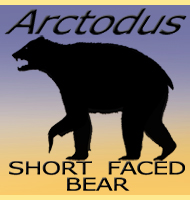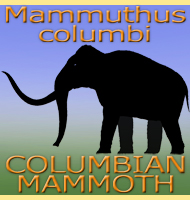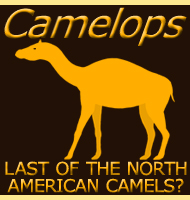


Cervalces
Name: Cervalces
(Stag moose).
Phonetic: Ser-val-ces.
Named By: Scott - 1885.
Classification: Chordata, Mammalia,
Artiodactyla, Cervidae.
Species: C. scotti, C. latifrons.
Diet: Herbivore.
Size: Around 2 to 2.5 meters long.
Known locations: Across Eurasia and North America.
Time period: Throughout the Pleistocene.
Fossil representation: Multiple specimens
Often
referred to as ‘Stag moose’, Cervalces was a
moose-like deer.
This means that it is considered to be a deer that adapted body
features that made it resemble a moose. With this in mind Cervalces
is thought to have fulfilled a similar ecological niche to the modern
day moose (Alces alces) and inhabited woodlands
and forests as well
as wading into water to search for suitable vegetation. Of the two
species, C. scotti is more often associated
with North American
fossils, while C. latifrons has a more Eurasian
distribution.
Principal
predators of Cervalces may have included grey
wolves (Canis
lupus)
and dire
wolves (Canis dirus), as
well as possibly
brown bears
(Ursus arctos). Grey wolves and brown bears are
known to hunt and
kill moose today, although brown bears tend to go after smaller
juveniles rather than fully grown adults, or alternatively steal the
kills of wolves. The dire wolf, being much more heavily built than
the grey would have had an even easier time bringing down large prey
like Cervalces. Another predator may have been
the American lion
(Panthera
leo atrox) as its close relative the Eurasian
cave lion
(Panthera
leo spelaea) is known to have had a preference
for deer
like animals, and it is possible that the American lion may have
shared this taste in prey. Additionally towards the end of the
Pleistocene period, the first human hunters would have also likely
targeted Cervalces for food.
Cervalces
vanished at the end of the Pleistocene along with most of the other
North American megafauna. Several theories from human hunting to
habitat change to disease have been proposed as explanation, but what
is certain is that whatever happened, it affected all of these
animals rather than just a few species. It’s just as possible however
that this mass extinction was caused by the combined effects of several
factors. There is a popular theory that C. scotti
became extinct
because of competition from the moose that crossed over Beringia (the
Bering land bridge) into North America from Asia. However the fact
that this species disappeared at the same time as the other North
American megafauna strongly counts against this, although competition
with the moose would have increased pressure upon C. scotti,
making it more susceptible to the survival conditions of the time.
----------------------------------------------------------------------------
Random favourites
 |
 |
 |



